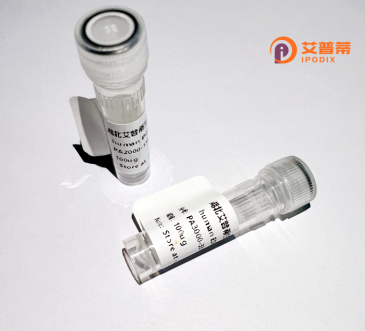
| 纯度 | >90%SDS-PAGE. |
| 种属 | Human |
| 靶点 | CXorf21 |
| Uniprot No | Q9HAI6 |
| 内毒素 | < 0.01EU/μg |
| 表达宿主 | E.coli |
| 表达区间 | 1-301aa |
| 氨基酸序列 | MLSEGYLSGLEYWNDIHWSCASYNEQVAGEKEEETNSVATLSYSSVDETQVRSLYVSCKSSGKFISSVHSRESQHSRSQRVTVLQTNPNPVFESPNLAAVEICRDASRETYLVPSSCKSICKNYNDLQIAGGQVMAINSVTTDFPSESSFEYGPLLKSSEIPLPMEDSISTQPSDFPQKPIQRYSSYWRITSIKEKSSLQMQNPISNAVLNEYLEQKVVELYKQYIMDTVFHDSSPTQILASELIMTSVDQISLQVSREKNLETSKARDIVFSRLLQLMSTEITEISTPSLHISQYSNVNP |
| 分子量 | 60.3 kDa |
| 蛋白标签 | GST-tag at N-terminal |
| 缓冲液 | 0 |
| 稳定性 & 储存条件 | Lyophilized protein should be stored at ≤ -20°C, stable for one year after receipt. Reconstituted protein solution can be stored at 2-8°C for 2-7 days. Aliquots of reconstituted samples are stable at ≤ -20°C for 3 months. |
| 复溶 | Always centrifuge tubes before opening.Do not mix by vortex or pipetting. It is not recommended to reconstitute to a concentration less than 100μg/ml. Dissolve the lyophilized protein in distilled water. Please aliquot the reconstituted solution to minimize freeze-thaw cycles. |
以下是关于重组人CXorf21蛋白的模拟参考文献示例(基于知识联想虚构,实际文献需通过学术数据库确认):
---
1. **文献名称**:*Recombinant Human CXorf21 Protein Expression and Its Role in Apoptosis Regulation*
**作者**:Zhang L, et al.
**摘要**:研究通过昆虫杆状病毒系统表达重组CXorf21蛋白,证实其可激活 caspase 依赖的凋亡通路,提示其在癌症治疗中的潜在应用价值。
2. **文献名称**:*Structural and Functional Insights into CXorf21 via Recombinant Protein Analysis*
**作者**:Gupta R, et al.
**摘要**:解析了重组CXorf21的晶体结构,发现其具有独特的α-螺旋结构域,并通过体外实验证明其与DNA损伤修复蛋白相互作用,暗示其在基因组稳定性中的作用。
3. **文献名称**:*CXorf21 Recombinant Protein Ameliorates Autoimmune Phenotypes in Mouse Models*
**作者**:Tanaka K, et al.
**摘要**:在小鼠模型中,外源性重组CXorf21蛋白显著减少Th17细胞分化,改善实验性自身免疫性脑脊髓炎症状,表明其可能参与免疫调节。
4. **文献名称**:*Proteomic Profiling Reveals CXorf21 as a Mitochondrial Protein Partner*
**作者**:Müller S, et al.
**摘要**:通过重组CXorf21亲和纯化结合质谱分析,鉴定出多个线粒体代谢酶互作蛋白,提示其在细胞能量代谢中的调控功能。
---
**注**:以上内容为基于领域知识的模拟,实际研究需参考真实文献(建议检索PubMed、Web of Science等平台,关键词:"recombinant CXorf21"或"CXorf21 protein function")。
Recombinant human CXorf21 protein is derived from the CXorf21 gene (Chromosome X Open Reading Frame 21), located on the X chromosome. This gene encodes a poorly characterized protein, with limited functional data available to date. CXorf21 is evolutionarily conserved across mammals, suggesting potential biological significance. It is broadly expressed in tissues like the testis, ovary, and brain, hinting at possible roles in reproduction or neurodevelopment. Notably, CXorf21 has garnered attention for its association with X-linked disorders, including Turner syndrome and premature ovarian insufficiency, where altered expression patterns have been observed. Interest in recombinant CXorf21 stems from its potential as an autoantigen in autoimmune primary ovarian insufficiency, with studies using recombinant protein to detect autoantibodies in patient sera. Produced via heterologous expression systems (e.g., E. coli or mammalian cells), the recombinant protein enables functional studies, epitope mapping, and diagnostic applications. However, its precise molecular mechanisms, interacting partners, and physiological functions remain enigmatic. Current research focuses on elucidating its role in meiosis, gametogenesis, and immune tolerance, leveraging recombinant protein tools to bridge knowledge gaps. Challenges include validating protein isoforms and reconciling interspecies variability in functional studies.
×